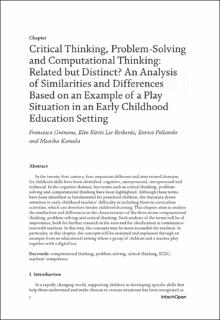| dc.contributor.author | Granone, Francesca | |
| dc.contributor.author | Reikerås, Elin Kirsti Lie | |
| dc.contributor.author | Pollarolo, Enrico | |
| dc.contributor.author | Kamola, Monika | |
| dc.date.accessioned | 2023-07-13T09:07:56Z | |
| dc.date.available | 2023-07-13T09:07:56Z | |
| dc.date.created | 2023-06-20T15:36:57Z | |
| dc.date.issued | 2023-05 | |
| dc.identifier.citation | Granone, F., Reikerås, E.K.L., Pollarolo, E. & Kamola, M. (2023) Critical thinking, problem-Solving and computational thinking : Related but Distinct : An analysis of similarities and differences based on an example of a play situation in an early childhood education setting. In: Teacher Training and Practice. IntechOpen | en_US |
| dc.identifier.isbn | 978-1-80356-909-3 | |
| dc.identifier.uri | https://hdl.handle.net/11250/3078545 | |
| dc.description.abstract | In the twenty-first century, four important different and intertwined domains for children’s skills have been identified: cognitive, interpersonal, intrapersonal and technical. In the cognitive domain, key terms such as critical thinking, problem-solving and computational thinking have been highlighted. Although these terms have been identified as fundamental for preschool children, the literature draws attention to early childhood teachers’ difficulty in including them in curriculum activities, which can therefore hinder children’s learning. This chapter aims to analyse the similarities and differences in the characteristics of the three terms computational thinking, problem-solving and critical thinking. Such analysis of the terms will be of importance, both for further research in the area and for clarification in communication with teachers. In this way, the concepts may be more accessible for teachers. In particular, in this chapter, the concepts will be analysed and explained through an example from an educational setting where a group of children and a teacher play together with a digital toy. | en_US |
| dc.language.iso | eng | en_US |
| dc.publisher | IntechOpen Limited | en_US |
| dc.relation.ispartof | Teacher Training and practice | |
| dc.relation.uri | https://www.intechopen.com/online-first/86662 | |
| dc.rights | Navngivelse 4.0 Internasjonal | * |
| dc.rights.uri | http://creativecommons.org/licenses/by/4.0/deed.no | * |
| dc.subject | barnehagelærerutdanning | en_US |
| dc.subject | lærerkompetanse | en_US |
| dc.title | Critical thinking, problem-Solving and computational thinking : Related but Distinct : An analysis of similarities and differences based on an example of a play situation in an early childhood education setting | en_US |
| dc.type | Chapter | en_US |
| dc.description.version | publishedVersion | en_US |
| dc.rights.holder | © 2023 The Author(s). | en_US |
| dc.subject.nsi | VDP::Samfunnsvitenskap: 200::Pedagogiske fag: 280::Allmennpedagogikk: 281 | en_US |
| dc.identifier.doi | 10.5772/intechopen.110795 | |
| dc.identifier.cristin | 2156314 | |
| dc.relation.project | Norges forskningsråd: 275576 | en_US |
| dc.relation.project | Norges forskningsråd: 326667 | en_US |
| cristin.ispublished | true | |
| cristin.fulltext | original | |
| cristin.qualitycode | 1 | |

